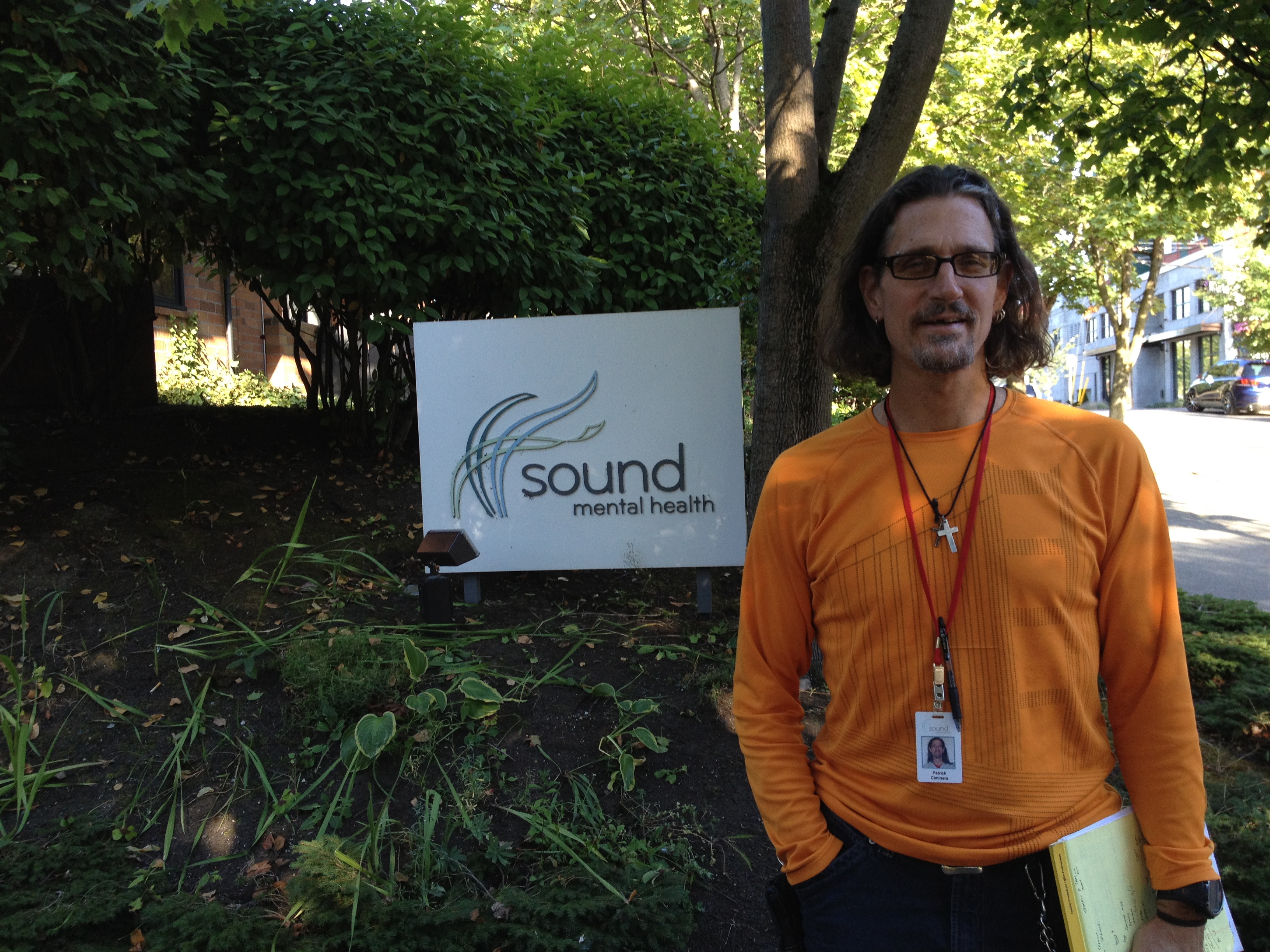Sound Mental Health has been providing behavioral and mental health services in Seattle for close to 50 years. There are thirteen locations around Seattle, with the administrative headquarters on East Olive here on Capitol Hill. Part of what SMH does is help people transition from a life in prison to a life back in society. They offer behavioral and mental health services to thousands of people throughout Seattle. After making a personal commitment to their recovery, and maintaining that recovery for some time, some of these people are given the opportunity to give back as Peer Counselors. Their stories often help people in similar situations, and they have a unique insight that often helps others seeking help.
CHS met with Patrick J Ciminera at the SMH administrative office where he shared his story. He’s a middle aged man with a runner’s physique, a good amount of grey in his goatee, and shoulder length hair. He spoke quietly, telling a story that he’s shared many times in the hopes of helping others.
Ciminera is in the process of incorporating a new nonprofit to raise funds to battle stigma surrounding mental illness and to provide assistance to further already successful programs that deal with the mentally ill. While he has not secured a 501c3 yet, he is asking for donations to help build the infrastructure and process the appropriate paperwork and such
If you would like to give to get this new venture started, you can contact him by email at [email protected].
Ciminera is an example of the reality around us — we need to live with and work with mental illness.
Ciminera was the youngest of six. He was born in Georgia, but grew up in California. His dad was out of the picture at the beginning, but then he came back. His view is that he had a typical childhood. He was raised Lutheran, went to a great school. He was a black belt in karate. “I was an outsider jock,” Criminera said. In high school he started drinking pretty heavily. This was between the years 1982-84. This was fairly common behavior, so it went fairly unnoticed.
After high school he earned his AA in philosophy at junior college, and then he attended UC Irvine, which is where the real troubles started. “Irvine had a bar on campus. I picked it for that,” said Ciminera. “My viewpoint was ridiculously skewed.” He started using narcotics and ended up dropping out.
He got clean while in a relationship that lasted a few years, but when that ended, he went back to Irvine and got back into drugs. Things got out of control, and his family came and convinced him to move back home. This didn’t last. He was beginning at this point to feel the day-to-day effects of living with what would later be diagnosed as schizophrenia. He moved to Washington State at this point, where he had an aunt and uncle, and became increasingly paranoid and symptomatic.
At 26, Ciminera had his first psychotic break. “I broke into a house and tried to kill and old man,” he said, as if describing the actions of some other person. Undiagnosed, he entered the Washington State correctional program. The judge recommended mental health treatment, but that was still a ways away for Criminera.
While in the Monroe Correctional Facility he had his second psychotic break, and he was finally given some psychological treatment. In 1998 he was diagnosed with Schizoaffective Disorder, and he spent 1998-2002 in the Special Offenders Unit. Then he was transferred to general population. “Jail wasn’t horrible,” he said. “It’s like a two-star hotel these days.”
There was never a conversion moment, or sudden insight. Ciminera’s improved state of mental health came slowly. They went through several different medications trying to treat his schizophrenia, finally finding one that worked for him. Habits he had known for years had to be changed. It was a long, slow process shifting his view from thinking that nothing and nobody could help. “I wanted to hear what people did to help,” he said. That was the decision that has informed every decision he’s since made.
“June 23, 2004, I got out and put together a life of meetings,” said Ciminera. He entered the Dangerous and Mentally Ill Offenders Program and he got into transitional housing. In 2005 he began attending Seattle Central Community College. In 2006 SMH helped him get into an apartment, and in 2008 he completed his second AA, His success story, his charisma, and his desire to help others led to Ciminera being asked to work with SMH as a Peer Counselor.
Next year he plans to run across the state as part of the Stampede Over Stigma. These days he’s a marathon runner. His goal is to run in five races this year. So far he’s done four. He likes to organize events for SMH clients, like taking people fishing and going to Mariners games.
“The Mariners know how to help people as an organization,” Ciminera said. They’ve offered an ever increasing number of free tickets to help out SMH, and these are always utilized. “I wish I could get people to donate fishing gear,” he said.





Thank you so much for writing his story and thanks to Ciminera for sharing it. The stigma around mental Illness keeps people away from desperately needed resources and I’m so happy that he was able to get assistance in the confusing and often unhelpful maze of social services.
Thank you for helping others learn there is a way out of the black hole of mental illness.Capitol Hill and Sound Mental Health are proud to work with you.
I’m in awe of Mr. Ciminera’s story because he’s achieved a degree of stability in his life that seems to be extremely difficult for many with major mental illnesses to reach. I’m desperate to know what went *right* with his treatment to get him to where he is. It’s like there must be a magic button somewhere, but what is it? I know patients at Sound who are compliant with their meds and are receiving treatment but still struggle with day-to-day life and can’t find stability. What can they do? What is the missing piece of the puzzle? Add to that the many, many more we are totally failing as a society and sometimes I just feel hopeless.
Thank you, though, for presenting a real success story. And best of luck to Mr. Ciminera in everything he does going forward.
Thanks for this great piece on working against mental health stigma! Folks interested in supporting Ciminera and his cause might also be interested in the Blue Carpet Project, which is hosting its first fundraiser tomorrow night. Details here: http://bluecarpetproject.com/
Thanks for the great story TomM. It’s double good news to hear that convicted felons with mental illness and substance abuse can and do turn their lives around and become productive members of society.
This sounds really good, this is the kind of support people need. I have my list of things I deal with and have sought treatment at SMH. It helped.
My younger brother is trapped in a prison system that is determined to ignore the mental health needs of their inmates. With out the support he needed coming out of prison this last time, he made mistakes early that he must now pay for. But in the mean time he will be off his meds, waiting for them to get around to “give him something”
I Love that Ciminera is open about his life, runs, and helps others acclimate, I love that the Mariners have taken a role by providing tickets. But it’s that you take people fishing that is beautiful.